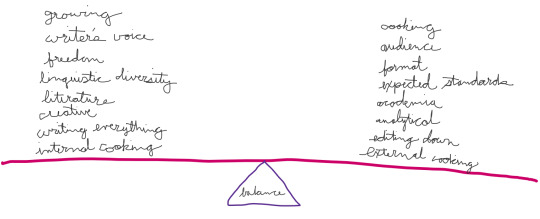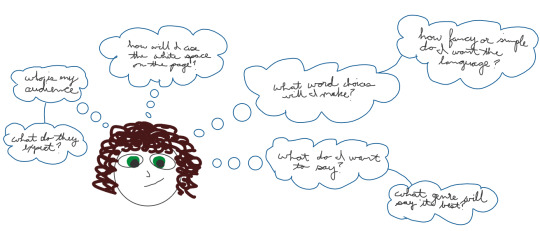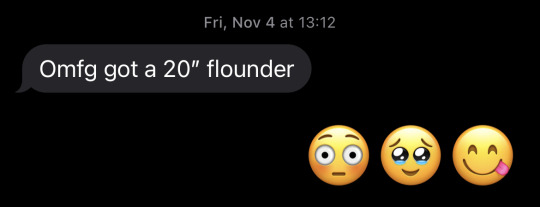Text
It’s Dangerous to Go Alone! Take These Keywords with You.
When it comes to writing (and teaching writing) there are a lot of theories out there to wade through. It's intimidating to put advice into practice. It can make it a little less scary to break multiple theories/advice into more manageable categories defined by specific keywords. I would like to share some that resonate most with me.
Balance is such an important component of writing because it ties together every other term that is relevant to putting theories into practice. There are so many theories and ideas about what is most important in writing that if you tried to follow every piece of advice it would give you a killer headache. The key to avoiding this is finding a balance between seemingly conflicting concepts. Only then can you achieve harmony of design and proportion in your writing practice. That is how "balance" is defined in terms of the art world and there's no reason not to consider your writing as art as well.
Though not explicitly, Peter Elbow discusses the importance of the balance between internal and external "cooking". He also explains how to balance "growing", which involves more pen-to-paper freewriting and the more deliberate process of "cooking."

The above diagram shows just some of the concepts that a writer and a teacher of writing would consider having to balance in their practice. This is not an exhaustive list, but it does include some essentials.
An in-class activity that looked at rhetorical situations made me balance particularly the audience's needs/wants and my own. Here is an expert of me processing how to present my topic while keeping these conflicting needs in mind: "...I know I will have to toe the line between respectful and sacrilegious. I don't know ahead of time the temperature of my audience, so to speak."
Along with balance, we need interaction in our writing. An example of this is the "cooking" that Elbow describes in Writing Without Teachers. We want several different concepts, ideas, and practices to mingle, get to know, and develop together. According to Elbow, this interaction is what makes writing interesting and multi-dimensional to the reader.

The diagram above represents an example "pot" with some of these elements interacting together as they simmer on the "stove" of your mind and paper and/or computer. The more you can work with different ideas and methods at one time the more interaction you will get. The more interaction you get, the more exciting your work can be to both you as the writer and to your reader.
Notice how some of the concepts in this "pot" are repeated from the balance scales. Part of the interaction between these writing elements is balancing. You want the right proportions of each element so the soup comes out tasting delicious, not bland. No one wants their writing to be bland, that's why you need to add multiples "flavors" to "season" it.
In order to juggle all these different processes and thoughts as a writer, you also need to involve some amount of creativity. Even in the seemingly most cut-and-dry academic writing, there is room to be creative. In fact, writing at its most basic core is a creative act. Through writing, you are bringing something entirely new into existence. Yes, it is often synthesized from preexisting ideas and methods, but you get to put it together in an entirely new shape and from a new perspective.
Wendy Bishop emphasizes the importance of this creativity, which she calls "risk taking" in her essay "When All Writing is Creative and Student Writing is Literature". She also goes on to say, "when writing classes don't highlight risk taking, it's hard to see the complicated ways authors go about their work." Bishop is talking about the multiple rewrites we writers go through and the different experiments we try in order to come up with a "finished" piece of writing.

In a process post on October 23, I asked the following questions in regard to allowing students to be creative in their writing:
"What better place for student writers to take risks and try new things with their writing than the classroom? What is a teacher really doing for their students if they don't foster a safe environment for that? How can a student confidently mix ingredients together in new ways in their work if that work keeps coming back to them covered in red marks scolding grammar and convention errors?"
With this creative freedom, some people may start to question if that would leave room to teach literacy skills. Stanley Fish thinks that you need to take a week with college students just going over basic sentence construction. But this is the man who referred to "students infected with the facile egalitarianism of soft multiculturalism" and wrote that, "you’re not going to be able to change the world if you are not equipped with the tools that speak to its present condition" in his article, What Should Colleges Teach? Part 3. With this in mind, maybe we shouldn't listen to people like him. In fact, Fish, Merrill Sheils (who wrote "Why Johnny Can't Write"), Nicholas Carr (who wrote "Is Google Making Us Stupid"), and others, have a rather narrow definition of literacy. If a person isn't capable of writing and reading their specific brand of English, it doesn't count as literacy to them.

The above snippet of a text conversation (between my husband and myself and shared with permission from both participants) is an example of newer literacies that people are developing around technology use. This snippet exemplifies how emojis can replace written words, saying so much more and taking less time and space to do so. In just three images, I was able to convey the nuanced emotions I felt about the freshly caught fish I knew I would be consuming in the next couple of days.
As I said in a process post on October 30:
"We are going to need to adapt our definitions of literacy and even how it's taught in schools. We've adapted before, online research methods weren't always taught but now it's commonplace. We can and must continue to adapt and evolve with the rest of society."
Those like Fish and Carr would probably shake their heads at the above conversation, but it's clear that many people are able to communicate through this method and have mastered it even.
With these terms in mind, hopefully putting theories into practice will be a less daunting task.
Further information can be found in the following links:
Peter Elbow's book Writing Without Teachers https://www.amazon.com/Writing-without-Teachers-Peter-Elbow-ebook/dp/B003GC9TYW
Wendy Bishop's article "When all Writing is Creative and Student Writing is Literature" https://blogs.baruch.cuny.edu/baruchteachingpracticum2015/files/2015/08/Bishop_WhenAllWritingIsCreative.pdf
Stanley Fish's article "What Should Colleges Teach? Part 3" https://archive.nytimes.com/opinionator.blogs.nytimes.com/2009/09/07/what-should-colleges-teach-part-3/
Merrill Sheils's article "Why Johnny Can't Write" https://www.leetorda.com/uploads/2/3/2/5/23256940/why_johnny_cant_write__newsweek_1975___1_.pdf
Nicholas Carr's article "Is Google Making Us Stupid" https://www.theatlantic.com/magazine/archive/2008/07/is-google-making-us-stupid/306868/
0 notes